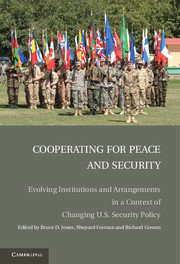 Cooperating for Peace and Security
Cooperating for Peace and Security Book contents
- Frontmatter
- Contents
- Contributors
- Foreword
- Acknowledgments
- I FRAMEWORK
- II ADAPTING COLD WAR INSTITUTIONS
- 4 An Evolving UN Security Council
- 5 Too Many Institutions? European Security Cooperation after the Cold War
- 6 Whither NATO
- 7 The Evolution of Nuclear Nonproliferation Institutions
- 8 9/11, the War on Terror, and the Evolution of Multilateral Institutions
- 9 Evolution and Innovation: Biological and Chemical Weapons
- III NEW TOOLS, NEW MECHANISMS
- IV CONCLUSIONS
- Index
- References
9 - Evolution and Innovation: Biological and Chemical Weapons
Published online by Cambridge University Press: 22 January 2010
- Frontmatter
- Contents
- Contributors
- Foreword
- Acknowledgments
- I FRAMEWORK
- II ADAPTING COLD WAR INSTITUTIONS
- 4 An Evolving UN Security Council
- 5 Too Many Institutions? European Security Cooperation after the Cold War
- 6 Whither NATO
- 7 The Evolution of Nuclear Nonproliferation Institutions
- 8 9/11, the War on Terror, and the Evolution of Multilateral Institutions
- 9 Evolution and Innovation: Biological and Chemical Weapons
- III NEW TOOLS, NEW MECHANISMS
- IV CONCLUSIONS
- Index
- References
Summary
Three international agreements attempt to contain the risks posed by weapons of mass destruction (WMD). These are the Nuclear Nonproliferation Treaty (NPT), which was agreed to in 1968 and entered into force in 1970; the Biological Weapons Convention (BWC), opened for signature in 1972 and entering into force in 1975; and the Chemical Weapons Convention (CWC), agreed to in 1992 and entering into force in 1997. Each agreement reflects the technical and political challenges of the weapon system that it addresses, and in this sense, each is self-evidently distinct. Yet the treaties all have their origins in the Cold War era; grapple with the issues of weapon definition, verification, and compliance; and are widely subscribed – most states belong to each. Moreover, it is possible to see some “learning” from one treaty to another, seen in the considerably more detailed terms of the BWC and CWC, which reflect a desire for greater specificity than can be found in the NPT. Together the three treaties constitute a strong international norm against the proliferation, further acquisition, or use of these indiscriminate weapons capable of causing great death and destruction.
This chapter explores how the two more recent agreements, the BWC and CWC, have unfolded in the years before and especially since the end of the Cold War (the NPT regime is discussed in Chapter 7).
- Type
- Chapter
- Information
- Cooperating for Peace and SecurityEvolving Institutions and Arrangements in a Context of Changing U.S. Security Policy, pp. 166 - 184Publisher: Cambridge University PressPrint publication year: 2009


